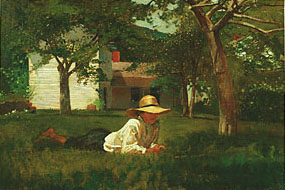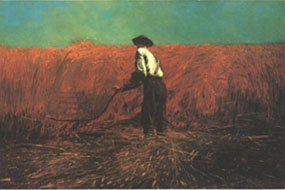 Grain and Milling in American Art -
Winslow Homer (1836-1910)
Winslow Homer, one of the most original American artistic talents of the nineteenth century, is famous for his Civil War and post-Civil War wood-engravings, which served the same purpose in periodicals such as Harper's Weekly that photographs do in journalism today. Boxwood blocks painted white had the artist's picture in reverse; an engraver cut out the white sections, so that the drawn lines could be used to print.
While Homer's on-the-scene portrayals of camp life and battle scenes during the Civil War are highly prized today, his real love was life in the country. After the war was over, he did two engravings that are similar in content to the scenes of the wheat harvest that Breughel painted three centuries earlier.
[1] These two engravings, "The Nooning," showing young farmers resting under a tree, is reminiscent of the peasants in the Breughel picture, while "The Veteran in a New Field," from Frank Leslie's Illustrated Newspaper, July 13, 1867, shows the Civil War veteran harvesting the tall, pre-hybrid wheat seen in the Breughel picture with a large scythe. The water-color version of this engraving was painted only a few months after Lee's surrender at the courthouse in Appomattox, VA., April 9, 1865.
[2]
The story in the newspaper that contains this engraving gives us a clue to the post-Civil War mood in the country:
one of the most conclusive evidences of the strength of a republican form of government is the way in which our army has disbanded, each man seeking again the sphere of usefulness which he left only temporarily, to aid the Government in its need...Now, however, that the war is over...we can well congratulate ourselves upon the manner in which the veterans have returned to their old fields or sought for new ones, since in this we find one of the surest proofs of the stability of our political system.
[3]
Other than the veteran's return to a normal life, there are other allusions to war in this picture, showing the depth of the national trauma just passed. Instead of a cradled scythe, the proper implement, he is using a single-blade scythe, the implement of the Grim Reaper, a symbol of death since medieval times.
[4] One interpretation of this picture is that the soldier is now cutting down grain instead of other Americans, in the bloodiest war Americans had ever fought. [5]
The other reference to war is from the well-known passage from the
Book of Isaiah, 2:4, which was often cited in writing of the period. [6]“And they shall beat their
swords into plowshares and their swords into pruning hooks; nation
shall not lift up sword against nation, neither shall they learn war
any more.”
Student Questions
"Veteran in a New Field"
Notes
Return to:
In-Depth Articles
 |
|||||

|

